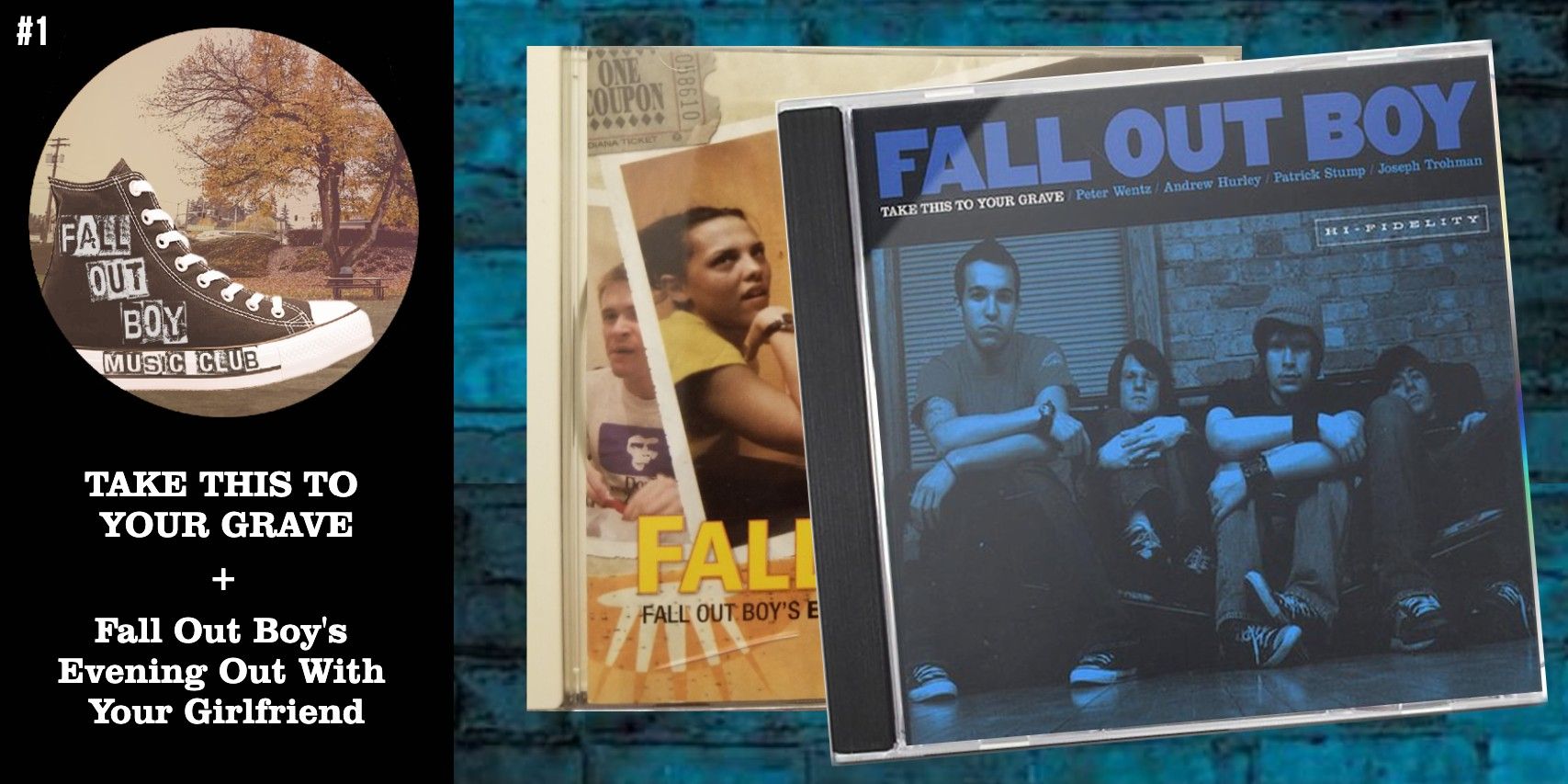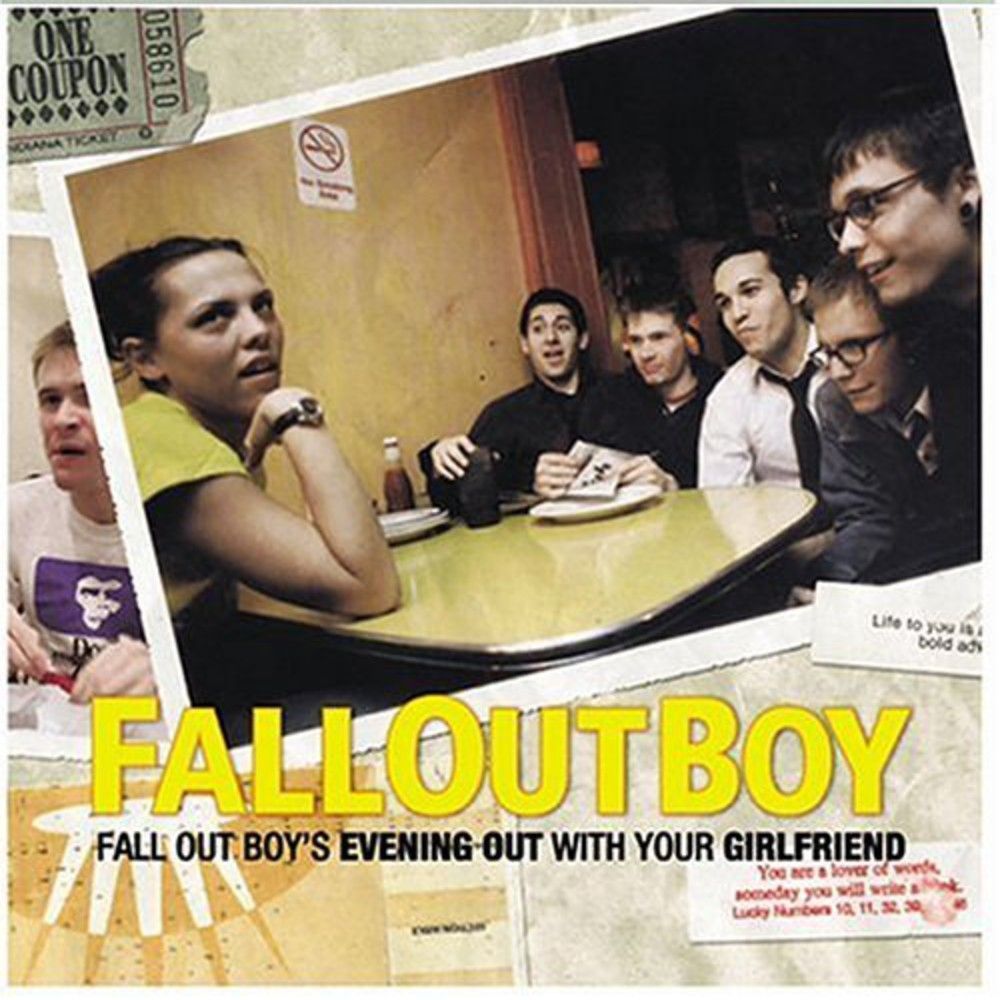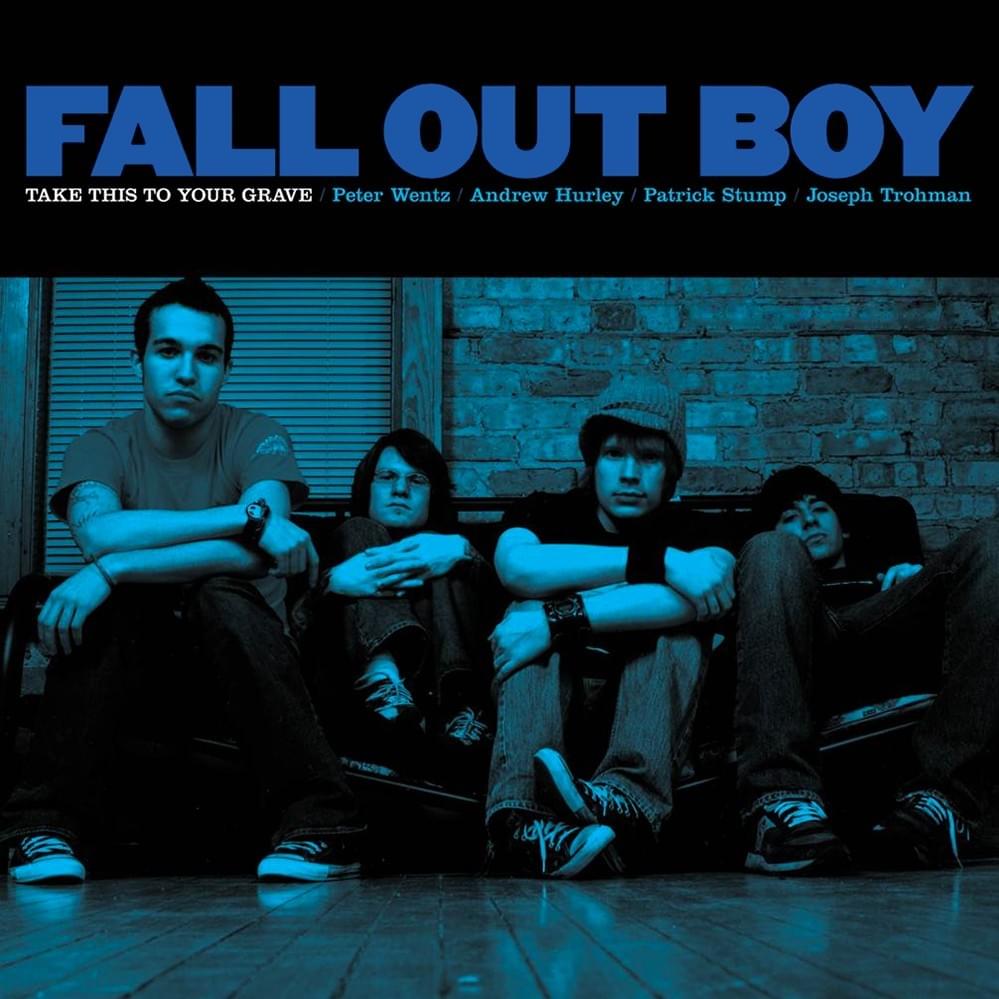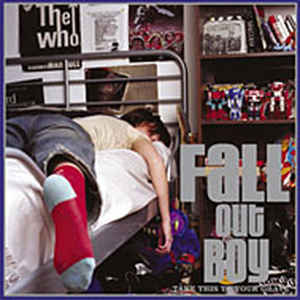FOBMC #1: "Take This to Your Grave"
and "Fall Out Boy's Evening Out With Your Girlfriend"

Welcome to the Fall Out Boy Music Club! This fall is the official fall of Fall Out Boy here at Friendmendations — every other week, we’ll analyze the discography of Chicago’s angstiest export. Share the link on social media! Get all your former-emo friends to join the club!
This week we’ll look at the origins of the band, from their disowned EP Fall Out Boy’s Evening Out With Your Girlfriend to their official debut, the seminal-in-some-circles Take This to Your Grave.

Fall Out Boy were always nerds. The band’s genesis was a conversation about the band Neurosis among 17-year-olds in a Border’s bookstore, and it sounds charmingly insufferable. Patrick Stump describes it this way: “Joe was talking loudly about Neurosis and I came in kind of snotty. He and his friend were trying to classify Neurosis and I came in to correct them, like an asshole.” Joe Trohman recalls, “I was taking really loud ’cause I talk really loud about Neurosis and other metal stuff, and he happened to hear and come over and popped in all weird and started talking to us. I ended up talking to him for an hour straight.”
Joe and Patrick hadn’t met before, but they were both involved in music in the area. Patrick was a drummer who played in a few unsuccessful bands. Joe was the guitarist for a few better ones, which is how he’d met Pete Wentz. Though Pete was five years older and something of a local celebrity in the hardcore scene, he and Joe became friends. They were trying to start a pop-punk band as a departure from the more metal groups they were both affiliated with, and Joe invited Patrick to audition after their meeting in Borders. Though he auditioned as a drummer, Joe and Pete were more impressed with his singing ability, and thus the band that would become Fall Out Boy was almost formed. They tried to recruit drummer Andy Hurley a few times, but he wasn’t interested in the project, so other musicians played drums for their local gigs.
The new band had been Pete Wentz’s idea, and witnesses have differing accounts for his motivation for starting it. Pete himself claims that he had the idea “on a lark” and thought it would be “easy and escapist,” “fun and hilarious,” with no intention of “getting big” or “selling out.” Sean Muttaqi, the owner of Uprising Records, remembers it differently. “Wentz and I were pretty tight at the time,” he said. “Wentz definitely looked at the band as the thing that would make him famous. He had a clear vision. Of all the guys from that scene, he was the most singularly focused on taking things to the next level.” Tim McIlrath, the Rise Against frontman who played with Pete in a band called Arma Angelus, paints a similar picture: “Pete was telling me at Arma Angelus practice that he was starting a pop-punk band and they would be gigantic and take over that world. He said that almost verbatim. He was dead-set on that.”
I’m inclined to believe McIlrath and Muttaqi from the evidence: though Joe was the stickler for practice, Pete was the one who hustled to get Fall Out Boy exposure and continued grinding until they were as successful as he’d (allegedly) predicted. After some time playing shows wherever they could get them, Pete’s connections led to the band’s first semi-official recording, Fall Out Boy’s Evening Out With Your Girlfriend. Five band members appear on the cover: one left the band before they even recorded the EP, and another would leave shortly after.

Evening Out With Your Girlfriend is okay. You can hear a lot of hints of the Fall Out Boy sound that would solidify later, but it’s not there yet. The opening of “Parker Lewis Can’t Lose (But I’m Gonna Try My Best)” sounds similar to future hit “Dance, Dance,” but much worse. “Growing Up” has a nice melody; it would be remixed for the career retrospective portion of “What A Catch, Donnie” and re-recorded for their greatest hits album. They would record a much better version of “Calm Before the Storm” for Take This to Your Grave.
The album lacks production polish, and the technical skill on display is questionable. It was recorded over the course of two days, and you can tell. Patrick was only 18 at the time and an inexperienced singer, and you can tell. Mike Pareskuwicz, drummer du jour, “couldn’t play without a click,” according to Joe, which in turn impacted his own playing. “Musically,” he concludes, “it’s just a giant piece of garbage!” Most notably for a Fall Out Boy record, Pete Wentz was completely absent from lyrical duties. All of the songs on Evening Out were written by Patrick, who was not particularly good at it. He refers to sex as “knocking boots” on one song. “Get me out of this one-horse town!” he sings on another, despite being from a suburb of Chicago. In one extremely 2002 touch, “Calm Before the Storm” drops a reference to Pink: “There’s a song on the radio that says ‘let’s get this party started.’”
The band no longer claims Evening Out as an official Fall Out Boy release for many reasons, one being that it doesn’t feature the kickass drumming of Andy Hurley. He would join them shortly after as a substitute drummer for a recording session for a split EP when their actual drummer couldn’t get the time off work to join them. Andy had been everyone’s first choice for the job anyway, and the songs were instantly elevated by his skills. When Fall Out Boy booked a short tour with another group, they convinced Andy to officially join the band.
The new lineup sounded better and the bandmates got along better, too. Patrick appreciated Andy’s musicality and shared reference points, and their partnership made the band’s sound tighter and more interesting. With their new, better recordings as a demo, Fall Out Boy eventually got a record deal. Their official debut, Take This to Your Grave, was released in 2003.

At the time of Grave’s recording, the band members were broke, Joe and Patrick were still teenagers, and the group only had 12 finished songs, so they just recorded all of them. “Part of me was thinking the band wouldn’t work out and I’d go to college and do some music on my own,” Patrick later said.
But with this album, Fall Out Boy perfectly crystallized the mix of catchiness and aggression that would define their particular strain of emo music. It’s a sound that’s in between pop-punk and hardcore, a watered-down version of the latter that Mani Mostofi, another Chicago musician who had played in a band with Pete, said that the bassist would jokingly describe as “softcore.” Mostofi describes it thusly: “An experienced hardcore musician could bring a sense of aggression and urgency to the pop hooks in a way that a band like Yellowcard could never achieve… Take This to Your Grave sounds like Hot Topic, but it feels like CBGB.”
Joe and Andy’s love of metal informed their style, and the guitars and drumming on the record were a huge step up from Evening Out, which had featured a different drummer and a second guitarist. The lyrics were better this time around, too, the result of a frustrating collaboration between Pete and Patrick.
Patrick was an artsy kid with wide-ranging musical interests and a powerful voice, and the band wouldn’t work at all without his talent and taste. The album’s memorable artwork was Patrick’s idea after the label rejected Pete’s far worse one. Pete had wanted a cluttered photograph crammed with pop-culture references: his girlfriend lying on his bed surrounded by band posters, CDs, action figures and boxes of Count Chocula. (The album’s photographer recalls, “Because it was clear that Pete had this vision for what the cover should be, the rest of the band kind of let us run with it.”) Their label pointed out that they couldn’t legally clear the use of those references, so the album art was thrown out. With a time crunch and only a few promotional photos to use instead, Patrick proposed designing an album cover around one of the group photos that referenced the classic designs of Blue Note jazz records. The result was something unique for the genre and far more iconic than their original concept.
Pete gladly took over the role of frontman for Patrick, who was more awkward and much less interested in the spotlight. But lyrical duties weren’t so evenly divided. Patrick hadn’t put much effort into lyrics on the previous album, so Pete asked to be involved more on Grave. The problem, I think, is that I’m not convinced that Pete Wentz knows anything about music. “The sound was always more important to me — the rhythm of the words, alliteration, syncopation were all very exciting to me,” said Patrick of their recording sessions. “Pete didn’t care about any of that. He was all meaning.” What this meant in practice — having a principle lyricist who didn’t care about things like rhythm — was that the two had to wrestle to fit Pete’s words into workable melodies. As Mostofi described their roles, “Pete was the emcee and Patrick was the musical conductor.”
Remarkably, the partnership worked, perhaps because they had to try so hard to nail down the process. Patrick contorted Pete’s angsty lyrics into catchy songs that suited his strong voice and provided his own in places where the song needed a change. In “Chicago Is So Two Years Ago,” for instance, Pete was the author of enjoyably bratty lines like the opening “My heart is on my sleeve, wear it like a bruise or black eye” and “Every little pat on the shoulder for attention / fails to mention I still hate you.” Patrick was responsible for the soaring, evocative chorus:
“But there’s a light on in Chicago
And I know I should be home,
All the colors of the street signs, they remind me of the
Pickup truck out in front of your neighbor’s house”
This album — and the band in general — succeed because of this push-and-pull, the way they balance the bitterness and immaturity with genuine emotion. The title of “Grenade Jumper,” for example, is a crude joke about the bandmates taking turns sleeping with unattractive girls so the rest of the band could crash on their couches or floors for the night, and the concept for the song started out as a joke, too. When Joe suggested writing a song “for the fans,” Patrick retorted that with the size of their crowds, the song would just be them onstage saying “Hey Chris!” to the friend who manned their merch table and handed out demos for them in those early days. But the resulting song is a sweet, open-hearted tribute to friendship. “You came to watch us play like a ‘big shot talent,’” they marvel. The chorus is just two lines: “Hey Chris, you were our only friend / And we know this is belated, but we love you back.”
On the album’s only charting single, “Grand Theft Autumn/Where Is Your Boy,” the song’s speaker fixates on proving to his ex that her new boyfriend is all wrong for her — “You hate him more than you notice / I wrote this for you” — but at the same time recognizes how pathetic he’s being. Every day, he says, he wakes up “willing to take my chances on the hope I’d forget.” Later in the song, he accounts his own flaws with self-deprecating sarcasm: “Someday I’ll appreciate in value / get off my ass and call you.” While other songs fling violent words at exes, this one is grounded in real feelings stilted by adolescent awkwardness. The central anxiety of the song (Oh my God, has she fucked him yet? Is he cheating on her?) is couched in vague questioning and uptight euphemism: “Where is your boy tonight? I hope he is a gentleman.” When the narrator finally says what he wants, it’s almost unbearably vulnerable. He offers to be anything she wants, to try to be better for her, even if she only gives in to loving him as a mistake: “You need him, I could be him / I could be an accident, but I’m still trying / and that’s more than I could say for him.” Even the production feels exposed: against Patrick’s protests, producer Sean O’Keefe insisted that the song begin with the chorus a capella. Removing the harsh instrumentation that Joe and Andy provided elsewhere on the track, Patrick’s soulful voice stands on its own, laying bare the narrator’s emotions.
I was a teenager when I first listened to Take This to Your Grave, which is the ideal time to experience it. It’s full of the kind of juvenile angst that would seem embarrassing later in their career but which was perfectly excusable at the time. Joe and Patrick were themselves still teenagers, after all. And Pete Wentz knew how to write about teenage heartbreak. He was dating a high schooler at the time.

Yeah. About that.
Pete was 23 when he began an off-and-on relationship with a 15-year-old girl named Jeanae, a fact that she obliquely confirmed in a 2020 podcast interview about her current job. (Without naming anyone specifically, she references a 4.5-year relationship with an older man that began when she was 15 and he was 23, and a Rolling Stone profile of the band mentioned her by name as Pete’s “sulky teenage muse” in 2007. That corroborates her timeline, as Pete would leave her for Ashlee Simpson later that year, and places the beginning of their relationship sometime in 2002, a year before Grave was recorded.) It’s possible that the songs on Grave aren’t about Jeanae at all; Pete also dated a teenager named Morgan, younger than him but older than Jeanae, around this time, and fan consensus is that it’s Morgan who appeared on the original Take This to Your Grave album cover. Regardless, the situation places the album’s frequent misogyny in starker relief. Lines like “With every breath, I wish your body would be broken again” and “Stop burning bridges and drive off of them,” problematic but standard for the genre, take on a darker implications when you wonder if they were aimed at the high school sophomore who was eight years younger than her boyfriend, or if it was a different teenager who would hear them and know they referred to her.
It also makes me question Pete’s involvement with their fan base early on. Mostofi, who attended the band’s early shows, said that “Pete made sure there was little division between the band and the audience” and that, at a show with only around 10 fans, “it was very clear that they all felt like they were Pete’s best friend.” McIlrath praised Pete’s early adoption of social media, “networking with their fans before any of us.” Chris Gutierrez, the subject of “Grenade Jumper,” recalled “a group of two dozen girls from Chicagoland area that would show up over and over again.” He said he’d mock Pete for signing autographs for these 14-year-old girls, but Pete didn’t want to hurt their feelings. Was he being sensitive and respectful of these girls as fans and people? Or was something creepier going on? Mostofi’s recollection of the band’s conception was as an outlet for Pete’s “softer side,” adding, “I remember him telling me that he wanted to start a band that more girls could listen to.”
I don’t have an answer to the question of how to separate art from the artist. I don’t think anyone does. Take This to Your Grave, though, is a truly collaborative effort, with half of the collaborators still in their teens. As uncomfortable as I am with Pete’s motivations, I still appreciate the talent and vision that the rest of the band brought to the project. I still remember what it was like to listen to this album as a teenager. Fall Out Boy would get bigger, more ambitious, and more eclectic after this, but they would never encapsulate youthful cynicism as well as they did here, nor make it sound anywhere near as fun. Take This to Your Grave is truly perfect pop-punk, packed with energy and emotions and hooks for days, and it holds up for anyone who wants to revisit a time when they experienced angst as intensely as they felt hope for their future and love for their friends.
Next time, we’ll dive deep on From Under the Cork Tree, the album that propelled Fall Out Boy to mainstream success. We’ll also take a closer look at the toxicity of Pete’s relationship with his “sulky teenage muse” and analyze how he built an emo empire. Will it more than you bargained for? We’ll see!
The Fall Out Boy Music Club logo was designed by Chuck Kaslow. Please tell your friends to join the club!
